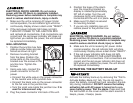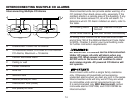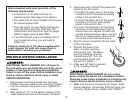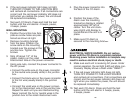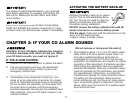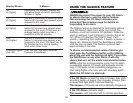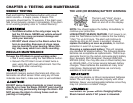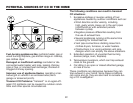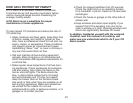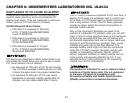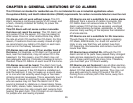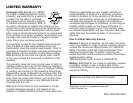
25
Once a minute, the alarm sounds 3
quick “chirps”, and the red light flashes
quickly three times and display reads
“Err”.
Based on its Self Test diagnostics, the
unit has detected a malfunction. The
unit needs to be replaced.
Units under warranty should be
returned to manufacturer for
replacement. See “Limited Warranty”
for details.
Once a minute, the red light flashes and
the horn “chirps” and flashing “bat”
displays continuously.
Low battery warning. Replace the 9V battery in the battery
back-up. Disconnect AC power before
changing the battery.
If your CO Alarm does this... This means... You should...
Red light is OFF. Unit will not alarm when
you press the Test/Silence button.
Unit may not be receiving any power. Check the AC power supply. Make sure
the power connector is securely
attached to the Alarm. Make sure a
fresh 9V battery is installed to power
the battery back-up.
Red light flashes once a minute (horn is
silent). Display shows “bat”.
Alarm is not receiving AC power. Unit is operating on DC battery back-
up. Check the AC power supply.
CHAPTER 7: TROUBLESHOOTING GUIDE
CO Alarm goes back into alarm
4 minutes after you press the
Test/Silence button.
CO levels are still potentially dangerous. Refer to Chapter 3 “If Your CO Alarm
Sounds” for details on how to respond to
an alarm. If anyone is feeling ill, EVACU-
ATE your home immediately and call 911.
If you have any questions that cannot be answered by reading this manual, call Consumer Affairs:1-800-323-9005.
CO Alarm sounds frequently even
though no high levels of CO are
revealed in an investigation.
The CO Alarm may be improperly
located. Refer to “Where to Install
Your CO Alarm.”
Relocate your Alarm. If frequent alarms
continue, have home rechecked for
potential CO problems. You may be
experiencing an intermittent CO problem.
ELECTRICAL SHOCK HAZARD. Turn off the power to the area where the CO Alarm is installed BEFORE
removing it from the mounting bracket or checking any electrical connections! Failure to turn off the power
first may result in serious electrical shock, injury or death.
The following guide can help you identify a potential problem with the installation or operation of your CO Alarm. It
is not meant to be an all-inclusive list of all CO Alarm conditions. If you are experiencing a condition not covered in
the next several pages, please contact Consumer Affairs.



